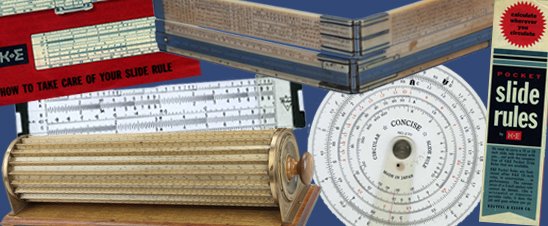In the late 19th and early 20th centuries, several circular slide rules were made to resemble pocket watches. Fowler & Co., of Manchester, England, was a particularly notable manufacturer of this type of slide rule.
- Description
-
In the late 19th and early 20th centuries, several circular slide rules were made to resemble pocket watches. Fowler & Co., of Manchester, England, was a particularly notable manufacturer of this type of slide rule. The company was in business from 1898 to 1988 and made a large variety of calculators, although the labor-intensive nature of its manufacturing process produced expensive instruments that never sold in large numbers.
-
This example is the "long scale" model, consisting of a metal case with a ring, two knobs, and two rotating paper discs covered with glass. The front has a short logarithmic scale and a long logarithmic scale, laid out in six concentric circles rather than in a spiral. These scales are rotated by the knob on the left. The glass is marked with two hairlines. The interior of the disc reads: FOWLER'S (/) LONG SCALE CALCULATOR (/) PATENT (/) FOWLER & Co MANCHESTER.
-
The other knob rotates the seven scales on the back of the instrument: multiplication and division, reciprocals, logarithms, square roots, logarithmic sines, logarithmic tangents, and a second scale for logarithmic sines. The interior is marked: FOWLER'S (/) CALCULATOR (/) PATENT (/) FOWLER & Co MANCHESTER. There is one hairline indicator on the glass. The slide rule is with a tarnished square metal case, lined with purple velvet. The outside of the case is engraved: Fowler's (/) CALCULATOR. The inside is stamped: Fowler & Co. (/) CALCULATOR (/) SPECIALISTS (/) Manchester (/) ENGLAND.
-
William Henry Fowler (1853–1932) and his son, Harold Fowler, took out several British patents for improvements to circular calculators between 1910 and 1924. The first Fowler calculator with two knobs on the rim was patented in 1914. In 1927, Fowler & Co. introduced the Magnum Long Scale Calculator, which extended the scale length to 50 inches. Thus, this example is dated between 1914 and 1927.
-
Charles Looney (1906–1987), the donor of this slide rule, catalogued engineering drawings and trade literature at the Smithsonian after he retired from the University of Maryland–College Park, where he served as chair of the Department of Civil Engineering. He also donated his library of books and pamphlets to the Museum.
-
References: Peter M. Hopp, "Pocket-Watch Slide Rules," Journal of the Oughtred Society 8, no. 2 (1999): 45–51; Richard Blankenhorn and Robert De Cesaris, "The Fowler Calculators: A Catalogue Raisonné," Journal of the Oughtred Society 11, no. 2 (2002): 3–11; Museum of History and Science in Manchester, "Fowler & Co.," http://www.mosi.org.uk/media/33870536/fowlerandco.pdf; accession file.
- Location
-
Currently not on view
- date made
-
1914-1927
- maker
-
Fowler & Co.
- ID Number
-
MA.333849
- catalog number
-
333849
- accession number
-
303780
